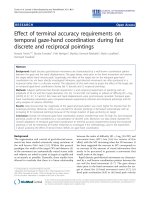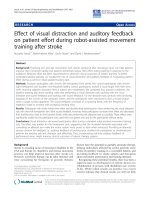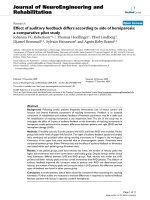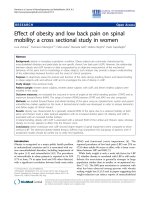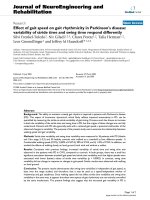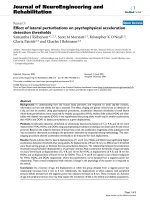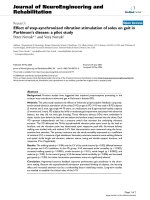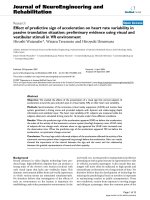Báo cáo hóa học: " Effect of growth temperature on the morphology and phonon properties of InAs nanowires on Si substrates" doc
Bạn đang xem bản rút gọn của tài liệu. Xem và tải ngay bản đầy đủ của tài liệu tại đây (651.53 KB, 7 trang )
NANO EXPRESS Open Access
Effect of growth temperature on the morphology
and phonon properties of InAs nanowires on Si
substrates
Tianfeng Li
1,3
, Yonghai Chen
1*
, Wen Lei
2
, Xiaolong Zhou
1
, Shuai Luo
1
, Yongzheng Hu
1
, Lijun Wang
1
, Tao Yang
1
and Zhanguo Wang
1
Abstract
Catalyst-free, vertical array of InAs nanowires (NWs) are grown on Si (111) substrate using MOCVD technique. The
as-grown InAs NWs show a zinc-blende crystal structure along a < 111 > direction. It is found that both the
density and length of InAs NWs decrease with increasing growth temperatures, while the diameter increases with
increasing growth temperature, suggesting that the catalyst-free growth of InAs NWs is governed by the
nucleation kinetics. The longitudinal optical and transverse optical (TO) mode of InAs NWs present a phonon
frequency slightly lower than those of InAs bulk materials, which are speculated to be caused by the defects in the
NWs. A surface optical mode is also observed for the InAs NWs, which shifts to lower wave-numbers when the
diameter of NWs is decreased, in agreement with the theory prediction. The carrier concentration is extracted to
be 2.25 × 10
17
cm
-3
from the Raman line shape analysis. A splitting of TO modes is also observed.
PACS: 62.23.Hj; 81.07.Gf; 63.22.Gh; 61.46.Km
Introduction
Semiconductor nanowires (NWs) have bee n intensively
studied in the last decade due t o their novel physical
properties and pot ential applications in high-perfor-
mance devices, such as field-effect transistors, lasers,
photodetectors, and photovoltaic devices [1-5]. Such
NWs are usually grown through vapor-liquid-solid
mode where metal nanoparticl es (Au, Ni, or other
metals) act as catalysts [6-9]. However, for certain mate-
rials the meta l catalysts can resul t in unintentional
incorporation into pure crystalline NWs, which causes
serious problems for materials doping and limits their
device applications. In order to avoid the co ntamination
from Au and other metal atoms, it is highly preferred
that NWs can be grown without catalysts.
On the other hand, one of the most attracting features
of NWs is that lattice mismatch or strain in NWs can
be significantly relaxed due to their high surface/volume
ratio and small lateral size. This can be used to realize
one of the dreams in semiconductor community–inte-
gration of III-V semiconductor on Si platform [10,11],
which presents a big challenge due to the significant lat-
tice mismatch and differences in coefficient of thermal
expansion between Si and III-V materials. The integra-
tion of III-V semiconductor on Si will allow people to
takeadvantageofboththekeyfeaturesofSilikelow
cost and mature processing technology and those of III-
V semiconductor like direct bandgap and high-quality
heterostr ucture growth. Among the III-V s emiconduc-
tors, InAs NWs possess excellent electron transport
properties such as high bulk mobility, small effective
mass, and low ohmic contact resistivity, which ca n be
used for preparing high-performance electronic devices
such as high mobility transistor [12,13].
Though some work has been done on catalyst-assisted
InAs NWs [8,14], little work has been devoted to cata-
lyst-free InAs NWs, especially on Si substrates [5,15,16].
In this paper, we present a study on the catalyst-free
synthesis and phonon properties of InAs NWs on Si
substrates. By varying the growth t emperature, InAs
NWs with different diameters were grown on Si sub-
strates. The phonon properties of the InAs NWs are
* Correspondence:
1
Key Laboratory of Semiconductor Material Science, Institute of
Semiconductors, Chinese Academy of Science, Beijing 100083, People’s
Republic of China
Full list of author information is available at the end of the article
Li et al. Nanoscale Research Letters 2011, 6:463
/>© 2011 Li et al; licensee Springer. This is an Open Access article distrib uted under the term s of the Creative Commons Attribut ion
License (http://creativecommons .org/license s/by/2.0), which permits unrestricted use, distribution, and reproduction in any medium,
provided the original work is properly cited.
investigated using Raman scattering characterization.
The effects of growth temperature on the frequency
shift of longitudinal optical (LO), transverse optical
(TO), and surface optical (SO) modes are analyze d.
Furthermore, a splitting of TO modes also is observed
and discussed.
Experimental details
Vertical InAs NWs arrays were grown on n-type Si
(111) substrates in a close-coupled showerhead metal-
organic chemical vapor deposition (MOCVD) system
(Thomas Swan Scientific Equipment, Ltd., Cambridge,
UK) at a pressure of 100 Torr. Trimethylindium (TMIn)
and AsH
3
were used as precursors and ultra-high purity
H
2
as carrier gas. First, Si substrates were cleaned (ultra-
sonicate in trichloroethylene, acetone, isoproponal, and
deionized water sequentially) and etched in buffered
oxide etch solution (BOE, six parts 40% NH
4
Fandone
part 49% HF) for 30 s to remove t he native oxide, and
then rinsed in deionized water for 15 s and dried with
N
2
. Then, the substrates were loaded into the MOCVD
chamber for growth. The substrates were heated up to
the growth temperature ranging from 530°C to 570°C,
and after 5-min stabilization time, the growth was
initiated by simultaneous introducing TMIn (2 × 10
-6
mole/min) and AsH
3
(2 × 10
-4
mole/min) into the reac-
tor chamber for 7 min. After the growth, InAs NWs
were cooled down with the protection of AsH
3
flow. To
obtain more underst anding about the controlled growth
of catalyst-free InAs NWs on Si, InAs N Ws were grown
at various temperatures ranging from 530°C to 570°C, i.
e., 530°C for sample A, 550°C for sample B and 570°C
for sample C. The morphology of InAs NWs was char-
acterized by field emission scanning electron microscopy
(S-4800, Hitachi, Tokyo, Japan) and high-re solution
transmission electron microscopy (HRTEM, Tecnai F20,
200 keV; FEI, Eindhoven, Netherlands). Raman scatter-
ing measurements were performed in backscattering
geometry at room temperature with a Jobin Yvon
HR800 confocal micro-Raman spectrometer (Horiba
Ltd., Longjumeau, France). Scattering configuration
z(x, x + y)z
(
x
[0
¯
11], y
[
¯
211], z
[ 111 ]
) was adopted.
The samples were excited by the 51 4.5 nm line of an
Ar-ion laser to a 1 µm spot on the surface with an exci-
tation power of 0.05 mW.
Results and discussion
Figure 1 shows the SEM images of samples A, B, and C.
It is observed that vertical and unif orm InAs NWs with
hexagonal cross section s are obtained in all the three
samples. With few exceptions, all InAs NWs are grown
along the < 111 > direction, which is perpendicular to Si
substrate surface. No large base islands are observed at
the base area surrounding NWs’ root, which is different
from the case of catalyst-assisted growth of NWs where
large base islands are usually observed [9]. This suggests
a different growth mechanismforcatalyst-freeInAs
NWs compared with catalyst-assisted InAs NWs.
According to p revious work [5], the large lattice mis-
match between InAs and Si could be the driving force
for such catalyst-free NW growth. InAs clusters/islands
firstnucleateinVolmer-WebermodeonSi,whereuni-
form film growth is prohibited due to the large interfa-
cial energy. Then, to relax the strain energy in the
sys tem, the InAs material is preferred to grow vertically
and form NWs. The few large InAs islands and non-ver-
tical InAs NWs observed in sample A, B, and C can be
explained by the reoxidation in the system, which pro-
vides nucleation sites and reactant sinks and also assist
in the growth of larger InAs islands and non -vertical
NWs [5,16].
Table 1 summarizes the statistical size information of
InAs NWs in the three samples. With increasing growth
temperature from 530°C to 570°C, the average density of
InAs NWs decreases from 8 to 4 μm
-2
,whiletheaver-
age diameter of InAs NWs increases from 35 to 70 nm.
Meanwhile, the average length of InAs NWs also
decreased from 2 to 1.2 μm with increasing growth tem-
perature. The change of NW density with increasing
growth temperat ure has also been observed in InAs
NWs on InP (111) B substrates [17]. The NWs density
is mainly governed by the nucleation kinetics of clusters
on the surfaces, and the NW density r is determined by
the materials deposition rate and growth temperature: r
∝ R/D(T), with R being the material deposition rate and
D(T) being the temperature-dependent coefficient of
surface diffusion. Therefore, the NW density will
decrease with increasing growth temperature. Such
change also indicates that InAs clusters or cluster-
related nucleation is initiated at the pre-stages of wire
growth. At proper temperatures, these clusters grow ani-
sotropically and form one-dimensional NWs. But at
lower temperatures, only a part of the clus ters follow
the anisotropic growth mechanism, others gro w by iso-
tropic exp ansion resulting in larger InAs islands. Indeed,
asshowninFigure1amoreInAslargeislandsare
observed in sample A, where InAs NWs are grown at
530 C. Apart from the decreased NW density, the aspect
ratio (length/width) of InAs NWs decreases significan tly
from 57.1 to 17.1 with incre asing temperature from 530°
C to 570°C. At higher temperatures, the radial growth
on the side facets becomes more significant, leading to
the formation of NWs with large diameter and small
length, and thus small aspect ratio.
To study the structural properties of InAs NWs,
HRTEM measurements were carried out. Figure 1d
shows the typical HRTEM image of InAs NWs
Li et al. Nanoscale Research Letters 2011, 6:463
/>Page 2 of 7
(sample B). It is observed that the InAs NW is uniform
in diameter. It should be noted that alternative dark and
bright contrast bands are observed, which can be attrib-
ute d to the rotation twins and stacking faults. Figure 1e
shows the HRTEM image of sample B with its inset
showing the fast Fourier transforms (FFTs) image. The
HRTEM image combining with FFT image indicates
that the InAs NWs has a cubic, zinc blend structure
and grows along the < 111 > direction normal to the Si
(111) substrate. Such rotation twins and stacking faults
are formed by random stacking of the closest-packed
planes during crystal growth, wh ich have also been
observed in III-V NWs grown along the < 111 > direc-
tion [18,19].
Figure 2a shows the Raman spectrum of InAs NWs in
sample B measured wit h incident laser beam parallel to
the c-axis of NWs. Three main scattering peaks are
observed, which are located a round 237.9, 230.0, and
216.2 cm
-1
, respectively. To probe the origin of these
three Raman peaks, Raman measurements are also per-
formed on bulk InAs (111) substrate for comparison,
the spectrum of which is shown in Figure 2b. For bulk
InAs materials, two Raman peaks are clearly observed:
one is located around 241.0 cm
-1
, the other around
218.7 cm
-1
, which can be attributed to the LO and TO
phonon modes of bulk InAs. Therefore, Raman peaks
locatedat237.9and216.2cm
-1
in Figure 2a can be
attributed to the LO and TO phonon mode of InAs
NWs. Except the downshift of their phonon frequency
relative to InAs bulk material, the LO and TO phonon
peaks of InAs NWs also show a larger full width at half
maximum. To explain such frequency downshift and
line-width broadening of LO and TO phonon peaks of
InAs NWs, three possible reasons should be taken into
account. One is the small lateral size of InAs NWs.
According to the “spatial correlation” model propo sed
by Richter et al. [20] and Tiong et al. [21], and also gen-
eralized by Campbe ll and Faucher et al. [22], the reduc-
tion in physical dimension of materials can lead to a
downshift of phonon frequency and a broadening of the
LO phonon peak due to the strong quantum
d
e
Figure 1 FE-SEM (45° tilted view) and TEM images of the InAs nanowires grown for 7 min on Si(111) substrates. Nanowires were (a)
grown at 530°C (sample A), (b) grown at 550°C (sample B), (c) grown at 570°C (sample C); (d) low-resolution TEM image of the nanowire. (e)
High-resolution image of a portion of the nanowires. The inset of (a) shows a higher magnification image of sample A; the inset of (b) is a top
view image; the inset of (e) shows the fast Fourier transform of the selected area on (e), which is viewed along the 0 [1-11] direction.
Table 1 Growth parameters and morphology statistics of
InAs NWs grown in sample A, B, and C
Sample Temperature H
2
flow rate D (nm) L (μm) r
(μm
-2
)
L/D
A 530°C 12 L/min 35 2.0 7-8 57.1
B 550°C 12 L/min 42 1.8 5-6 42.9
C 570°C 12 L/min 70 1.2 3-4 17.1
Morphology statistics: average diameter, average length, and average density.
Li et al. Nanoscale Research Letters 2011, 6:463
/>Page 3 of 7
confinement and the relaxation of q = 0 selection rule.
However, the diameter of our InAs NWs is very large (>
20 nm) and shows almost no quantum confinement
effect, which cannot explain the observed downshift in
phonon frequency of LO and TO phonon peaks.
Another one is the thermal anharmonicity effect caused
by temperatu re change. Anharmonicity entails the parti-
cipation of phonons at frequencies multiple of the fun-
damental in the scattering events [23]. Such anharmonic
effects become prominent at higher temperatures due to
the larger extent of lattice vibrations, and are irrespec-
tive of the longitudinal or transverse character of the
phonon modes. Theoretically, an increase in tempe ra-
ture can induce both line-width broadening and fre-
quency downshift of phonon peaks. However, our
Raman spectra are measured under a low laser excita-
tion power of 0.05 mW, where the heating effect can be
ignored. The last one is the existence of structural
def ects in NWs. As indicated by the work on GaAs and
InAs NWs grown on SiO
2
and GaAs substrates, defects
can cause a frequency downshift and line-width broad-
ening t o the phonon peaks [8]. As shown by the
HRTEM study, defects like rotation twins and stacking
faults exist in the samples, which might relax the q =0
selection rule and lead to the frequency downshift and
line-width broadening of the phonon peaks.
As shown in Figure 2, beside LO and TO phonon
peaks, there is another phonon peak centered around
230.0 cm
-1
, which can be attributed to the SO phonons.
Such SO phonon modes have also been observed in
GaP, ZnS, GaAs, and InAs NWs [24-32]. According to
the model proposed by Ruppin and Englman [27], the
frequency of SO phonon mode in a cylinder NW can be
calculated by the expression
ω
SO
= ω
TO
ε
0
+ ε
m
ρ
ε
∞
+ ε
m
ρ
,
(1)
ω
2
SO
= ω
2
TO
+
ω
2
p
ε
∞
+ ε
m
· ρ
(2)
Where ω
SO
is surface phonon frequency; ω
TO
is TO
phonon frequency; ω
p
is the screened ion plasma fre-
quency, ε
0
and ε
∞
arestaticanddynamicdielectriccon-
stants, respectively; ε
m
is dielectric constant of the
surrounding medium and r is expressed as:
ρ =
K
1
(x)I
0
(x)
K
0
(x)I
1
(x)
,
(3)
where K
n
(x) and I
n
(x)(n = 0,1) are the modified Bessel
functions and x = qr (r being the radius of the NW). For
InAs materials, the following parameters are used for
the calculation: ε
0
= 13.9, ε
∞
= 11.6, ε
m
=1(theNWs
are immersed in air) [15], ω
TO
=216.7cm
-1
.Theplas-
mon frequency ω
p
can be related to the free carriers
concentration (n) and effective electron m ass of InAs
(m* = 0.024m
e
) [15],
ω
2
p
=
π ne
2
ε
∞
m
∗
(4)
Vice versa, the free carrier concentration can be calcu-
lated if the frequency of SO phonon mode and the size of
the NWs are known. Here, the free carrier concentration
160 180 200 220 240 260 280 300
Intensity (a.u.)
Raman shift (cm
-1
)
InAs NWs
InAs bulk
a)
b)
100 150 200 250 300 350 400 450 500
Intensity (a.u.)
Raman shift (cm
-1
)
93K
133K
173K
213K
253K
293K
TO
SO
LO
c)
Figure 2 Raman spectra of InAs nanowires and temperature-dependent Raman shift.(a) Micro-Raman spectra of InAs nanowires with an
average diameter of 42 nm. The black line is the recorded data while the lighter colored (green) lines are results from a multiple Lorentzian fit;
(b) Raman spectrum from bulk (111) InAs; (c) Temperature-dependent Raman shift of the TO, SO, and LO phonon mode of InAs NWs.
Li et al. Nanoscale Research Letters 2011, 6:463
/>Page 4 of 7
in sample B is estimated to be 2.25 × 10
17
cm
-3
using the
measured diameter (42 nm) and SO phonon frequency
(230.0 cm
-1
). This result is close to the value obtained
through electrical measurements in [5]. This high free
carrier concentration in the InAs NWs might be caused
by the unintentional doping due to carbon background
incorporation [5]. To get more understanding of this SO
phonon mode in InAs NWs, temperature-dependent
Raman measurements are also performed on the InAs
NWs in sample B, the results are shown in Figure 2c. It is
observed that the SO phonon peak shifts to lower fre-
que ncy with increas ing the temperature, which is similar
to the temperature behavior of the LO and TO mode of
InAs NWs, and can be explained by the lattice expansion
in NWs. It should be noted that though the SO feature is
not apparent at high temperatures (> 173 K) the free car-
rier concentration should still be around the value (2.25
×10
17
cm
-3
) at low temperatures considering the fact
that the free carrier concentration induced by uninten-
tionally doping is much higher than that of intri nsic car-
rier in InAs materials (~1 × 10
15
cm
-3
).
Apart from sample B, Raman experiments are also
performed on sample A and C. Figure 3 shows Raman
spectra of InAs NWs measured with incident laser beam
parallel to the c-axis of NWs at room temperature. As
stated above, the phonon peaks on low energy side of
LO phonon modes a re from SO phonon modes.
Obviously, the SO phonon peak shifts toward lower
energy side with reducing NWs’ diame ter. More inter-
estingly, for InA s NWs with smaller diameters (larger
surface-to-volume ratio), the SO phonon mode can be
more clearly distinguished. These features further
indicate that the Raman peak located between TO and
LO phonon peaks can, indeed, be attributed to the scat-
tering from surface phonons. According to the model
stated above, the phonon frequency of SO mode can be
calculated according to the diameter of NWs. Figure 3b
shows the calculated phonon frequency of SO mode in
InAs NWs with various diameters an d the experimen-
tally measured phonon frequency of SO mo de of InAs
NWs in sample A, B, and C. Obviously, the experimen-
tal values agree well with the theoretical values, con-
firming the SO mode origin of the Raman peak between
LO and TO phonon peaks.
Figure 4 shows the Raman spectra of InAs NWs with
a diameter of 42 nm (sample B) measured with the inci-
dent l aser beam both parallel
(z(x, x + y ) z)
and perpen-
dicular
(x(z, z + y)x)
to the c-axis of NWs. Note that the
laser excitation power used for measuring Raman spec-
trainFigure4is0.25mW.ComparedwiththeTO
peak measured with incident laser beam parallel to c-
axis of NWs, the TO peak measured with incident laser
beam perpendicular to c-axis of NWs shifts to lower fre-
quency with asymmetric broadening, where a weak
shoulder peak appears at the lower energy side of TO
mode. This indicates a possible splitting of TO mode,
giving rise to A
1
(TO) mode reported [31]. A more
detailed s tudy on the splitting as a function of the NW
crystal structure, strain, diameter, and length is currently
under way.
Conclusion
To summarize, the catalyst-free , growth, and phonon
properties of InAs NWs on Si (111) substrates are
180 200 220 240 260
Intensity (a.u.)
Raman shift (cm
-1
)
d
av
=70 nm
d
av
=42 nm
d
av
=35 nm
0 20 40 60 80 100 120 140 160
216
220
224
228
232
236
Experimental
Theortical
Raman shift (cm
-1
)
Diameter
(
nm
)
Figure 3 Raman spectra of InAs NWs measured with different average diameter and theoretical prediction.(a) Raman spectra from InAs
NWs with average diameters from 35 nm (red), 42 nm (black), and 70 nm (blue). The lighter colored (green) lines are results from a multiple
Lorentzian fit. The vertical line is a guide to the eye. The position of SO phonon down shifts with the decrease in diameter; (b) Dependence of
the position of the SO phonon from the diameter of the NWs. The points represent experimental data obtained from several measured samples
with different average diameters. The line corresponds to the theoretical prediction for cylindrical InAs NWs.
Li et al. Nanoscale Research Letters 2011, 6:463
/>Page 5 of 7
investigat ed in detail in thi s paper. Both the density and
the length of InAs NWs decrease with increasing growth
temperatures, while the diameter of InAs NWs increases
with increasing growth temperature, sugges ting that the
catalyst-free growth of InAs NWs are governed by the
nucleation kinetics in the system. The LO and TO
mode of InAs NWs both present a phonon frequency
smaller lower than those of InAs bulk materials, w hich
is speculated to be mainly caused by the defects in the
NWs. Apart from LO and TO phonon modes, a SO
mode is also observed for the InAs NWs, the signal fea-
ture of which becomes more prominent with reducing
the diameter of NWs due to the increased surface/
volume ratio. A splitting of transverse optical (TO)
modes also is observed.
Abbreviations
NWs: nanowires; MOCVD: metal-organic chemical vapor deposition; LO:
longitudinal optical; TO: transverse optical; SO: surface optical; SEM: scanning
electron microscopy; HRTEM: high-resolution transmission electron
microscopy.
Acknowledgements
The work was supported by the National Natural Science Foundation of
China (No. 60625402 and 60990313), and the 973 program.
Author details
1
Key Laboratory of Semiconductor Material Science, Institute of
Semiconductors, Chinese Academy of Science, Beijing 100083, People’s
Republic of China
2
Department of Electronic Materials Engineering, Research
School of Physics and Engineering, The Australian National University,
Canberra, ACT 0200, Australia
3
Department of Physics, Tsinghua University,
Beijing 100084, People’s Republic of China
Authors’ contributions
TL carried out the experimental analysis and drafted the manuscript. YC
carried out the experimental design. WL and XZ participated in the
experimental analysis. SL carried out the growth and optimization of InAs
NWs. YH participated in the experimental measurement. LW participated in
its design and coordination. TY and ZW participated in the experimental
design. All authors read and approved the final manuscript.
Competing interests
The authors declare that they have no competing interests.
Received: 15 April 2011 Accepted: 21 July 2011 Published: 21 July 2011
References
1. Yan RX, Gargas D, Yang PD: Nanowire photonics. Nature Photonics 2009,
3:569.
2. Lu W, Lieber CM: Semiconductor nanowires. J Phys D 2006, 39:R387.
3. Patolsky F, Lieber CM: Nanowire nanosensors. Mater Today 2005, 8:20.
4. Li Y, Qian F, Xiang J, Lieber CM: Battery betters performance energy
generation. Mater Today 2006, 9:18.
5. Wei W, Bao XY, Soci C, Ding Y, Wang ZL, Wang DL: Direct Heteroepitaxy
of vertical InAs nanowires on Si substrates for broad band photovoltaics
and photodetection. Nano Lett 2009, 9:2926.
6. Tomioka K, Motohisa J, Hara S, Fukui T: Control of InAs nanowire growth
directions on Si. Nano Lett 2008, 8:3475.
7. Zhang RQ, Lifshitz Y, Lee ST: Oxide-assisted growth of semiconducting
nanowires. Adv Mater 2003, 15:635.
8. Begum N, Piccin M, Jabeen F, Bais G, Rubini S, Martelli F, Bhatti AS:
Structural characterization of GaAs and InAs nanowires by means of
Raman spectroscopy. J Appl Phys 2008, 104:104311.
9. Dayeh SA, Yu ET, Wang DL: III-V nanowires growth mechanism: V/III ratio
and temperature effects. Nano Lett 2007, 7:2486.
10. Mokkapati S, Jagadish C: III-V Compound SC for optoelectronic devices.
Mater Today 2009, 12:22.
11. Tomioka K, Motohisa J, Hara S, Hiruma K, Fukui T: GaAs/AlGaAs core
multishell nanowire-based light-emitting diodes on Si. Nano Lett 2010,
10:1639.
12. Adachi S: Properties of Group-IV, III-V and II-VI semiconductors New York:
Wiley; 2005.
200 220 240 260
Intensity(a.u.)
Raman shift (cm
-1
)
parallel to c-axis
perpendicular to c-axis
a)
b)
A
1
(LO)
E
1
(TO)
E
1
(TO)
A
1
(LO)
SO
Figure 4 R aman spectra of InAs NWs recorded parallel and perpendicular to the c-axis.(a) Raman spectra of as-grown vertical aligned
InAs NWs (sample B) recorded in backscattering geometry parallel to the c-axis, (b) Raman spectra of InAs NWs recorded perpendicular to the c-
axis of nanowires. Excitation laser power 0.25 mW, the lighter colored (green) lines are results from a multiple Lorentzian fit.
Li et al. Nanoscale Research Letters 2011, 6:463
/>Page 6 of 7
13. Dayeh SA, Aplin D, Zhou XT, Yu PKL, Yu ET, Wang DL: High electron
mobility InAs nanowire field-effect transistors. Small 2007, 3:326.
14. Xu XX, Yu KH, Wei W, Peng B: Raman scattering in InAs nanowires
synthesized by a solvothermal route. Appl Phys Lett 2006, 89:253117.
15. Cantoro M, Klekachev AV, Nourbakhsh A, Soree B, Heyns MM, Gendt SD: Eur
Phys J B 2011, 79:423.
16. Cantoro M, Wang G, Lin HC, Klekachev AV, Richard O, Bender H, Kim TG,
Clemente F, Adelmann C, Veen MH, Brammertz G, Degroote S, Leys M,
Caymax M, Heyns MM, Gendt SD: Large-area, catalyst-free heteroepitaxy
of InAs nanowires on Si by MOVPE. Phys Status solidi A 2011, 208:129.
17. Mandl B, Stangl J, Martensson T, Mikkelsen A, Eriksson J, Karlsson LS,
Bauer G, Samuelson L, Seifert W: Au-free epitaxial growth of InAs
nanowires. Nano Lett 2006, 6:1817.
18. Woo RL, Xiao R, Kobayashi Y, Gao L, Goel N, Hudait K, Mallouk TE, Hicks RF:
Effect of twinning on the photoluminescence and photoelectrochemical
properties of indium phosphide nanowires grown on silicon (111). Nano
Lett 2008, 8:4664.
19. Bao JM, Bell DC, Capasso F: Optical properties of rotationally twinned InP
nanowire heterostructures. Nano Lett 2008, 8:836.
20. Richter H, Wang ZP, Ley L: The one phonon Raman spectrum in
microcrystalline silicon. Solid State Commun 1981, 39:625.
21. Tiong KK, Amirtharaj PM, Pollak FH, Aspnes DE: Effects of As ion
implantation on the Raman spectra of GaAs: “Spatial correlation”
interpretation. Appl Phys Lett 1984, 44:122.
22. Campbell IH, Fauchet PM: The effect of microcrystal size and shape on
the one phonon Raman spectra of crystalline semiconductors. Solid State
Commum 1986, 58:739.
23. Balkanski M, Wallis RF, Haro E: Anharmonic effects in light scattering due
to optical phonons in silicon. Phys Rev B 1983, 28:1928.
24. Adu KW, Xiong Q, Gutierrez HR, Chen G, Eklund PC: Raman scattering as a
probe of phonon confinement and surface optical modes in
semiconducting nanowires. Appl Phys A: Mater Sci Process 2006, 85:287.
25. Spirkoska D, Abstreiter G, Morral AF: Size and environment dependence of
surface phonon modes of gallium arsenide nanowires as measured by
Raman spectroscopy. Nanotechnology 2008, 19:435704.
26. Begum N, Bhatti AS, Jabeen F, Rubini S, Martelli F: Lineshape analysis of
Raman scattering from LO and SO phonons in III-V nanowires.
J Appl
Phys 2009, 106:114317.
27. Ruppin R, Englman R: Optical phonons of small crystals. Rep Prog Phys
1970, 33:149.
28. Hayashi S, Kanamori H: Raman scattering from the surface phonon mode
in GaP microcrystals. Phys Rev B 1982, 26:7079.
29. Gupta R, Xiong Q, Mahan GD, Eklund PC: surface optical phonons in
gallium phosphide nanowires. Nano Lett 2003, 3:1745.
30. Xiong Q, Wang JG, Reese O, Voon LC, Eklund PC: Raman scattering from
surface phonons in rectangular cross-sectional w-ZnS nanowires. Nano
Lett 2004, 4:1991.
31. Zardo I, Conesa-Boj S, Peiro F, Morante JR, Arbiol J, Uccelli E, Abstreiter G,
Morral AF: Raman spectroscopy of wurzite and zinc-blende GaAs
nanowires: Polarization dependence, selection rules, and strain effects.
Phys Rew B 2009, 80:245324.
32. Jeganathan K, Debnath PR, Meijers R, Stoica T, Calarco R, Grutzmacher D,
Luth H: Raman scattering of phonon-plasmon coupled modes in self-
assembled GaN nanowires. J Appl Phys 2009, 105:123707.
doi:10.1186/1556-276X-6-463
Cite this article as: Li et al.: Effect of growth temperature on the
morphology and phonon properties of InAs nanowires on Si substrates.
Nanoscale Research Letters 2011 6:463.
Submit your manuscript to a
journal and benefi t from:
7 Convenient online submission
7 Rigorous peer review
7 Immediate publication on acceptance
7 Open access: articles freely available online
7 High visibility within the fi eld
7 Retaining the copyright to your article
Submit your next manuscript at 7 springeropen.com
Li et al. Nanoscale Research Letters 2011, 6:463
/>Page 7 of 7


